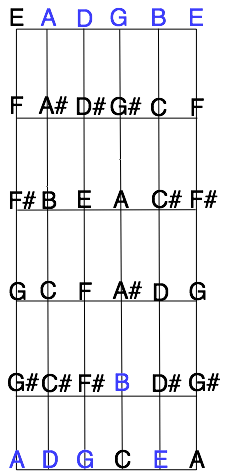how to tune
I firmly believe that anybody who fully absorbs the lessons on this site will be well-situated to advance into any guitar-playing realm imaginable. You will have learned basic chords and strumming, been introduced to the wonderful world of music reading, practiced your first seven major scales until they’re in your bones, and how to find any note anywhere on the neck you wish. Unfortunately all of this won’t amount to much if you can’t keep your guitar in tune, so this needs to be addressed as well.
We’re going to learn to tune the guitar to itself. The video below will provide the pitch for your Low E string. I recommend that you match that on your guitar and then proceed by matching the A string to the 5th fret of the Low E, the D string to the 5th fret of the A string, the G string to the 5th fret of the D string, the B string to the 4th fret of the G string, and finally the High E to the 5th fret of the B string. Here’s a visual:

While you’re doing this procedure you have to listen very carefully. There are two questions you need to ask yourself, first one being “Do the two strings have the same basic pitch?” The best way to determine this is to hum the fretted note, followed by the open string. If your voice needs to change in order to match the open string the answer to this question is no, and you will need to tune accordingly. Turning the tuning pegs clockwise will result in a lower pitch, while a counter-clockwise turn will tighten the string resulting in a higher pitch. Be aware that matching pitches with your voice will in itself take some practice. Again, patience is a necessity. You don’t need to be Pavarotti here so go easy on yourself.
The next question to ask yourself is “Do I hear a wavy sound?” The wavy sound I speak of is often mistaken by beginners, but once known to you it will be unmistakable. The wavy sound I speak of occurs when two sounds are very close to one another in pitch. This results in a clashing of the vibrations emitted by the strings characterized by a warble that I have come to refer to as a “wave”. If you hear this sound it means that you are quite close, but you need to do some fine tuning. Sometimes when you’re this close it’s difficult to determine which direction to proceed in. If you don’t know which way to go, just go with your gut and give it a little crank in the direction you choose. There are three possible outcomes. If the wavy sound will get slower and less severe, fantastic. That means you’re getting closer, and you should continue in the same direction will small turns until the wave disappears completely. If the wave sound gets more intense, you’re going the wrong way, and you should proceed with modest turns in the opposite direction. The most frustrating of the three possible outcomes is when there is no perceptible change. This brings me to my number one rule of tuning, which is do not change direction unless you are absolutely certain that you have been going in the wrong direction. Changing directions without certainty leads to tuning purgatory. The last thing you want to do is go back and forth, desperately trying to hit a home run. If you are patient, and get in the habit of using this method you will eventually be able to tune a guitar perfectly in a matter of seconds.
This brings me to another FAQ, which is “How am I supposed to tune the Low E string?” There are a number of ways you can do this. If you’ve got a keyboard of some sort you can match it with the key two E’s below middle C. If you don’t have a keyboard, you can get a pitch pipe that will produce the correct pitch. Sometimes when I’m in a pinch I’ll tune my guitar to AC/DC’s “Back In Black”, which is a perfectly tuned E. One important thing to keep in mind is that even if your Low E isn’t perfectly in tune your guitar will still sound great by itself if you follow the above steps. The good news is that while your on my site you’ve got the video below demonstrating what an in-tune Les Paul should sound like. Use the Low E to start tuning your guitar and proceed using the steps outlined above. Finally, you can always get an electronic tuner that you can use to tell exactly what you need to do with each string. Don’t take any shortcuts yet, though. I can absolutely promise that at some point you will wish you were able to tune by ear, and if you internalize this method of tuning you’ll be a whiz.
